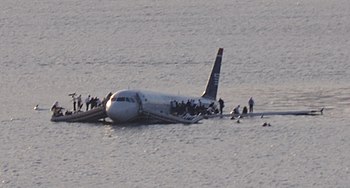
An Air Niugini jet lands in the water, short of the runway. On Friday, September 28, 2018 passengers aboard a commercial airliner got an unexpected exit from their airplane after their flight landed in the water. They were ferried to land courtesy of local fisherman in the harbor. It was not your typical landing!

Air Niugini is the national airline of Papua New Guinea (http://airniugini.com.pg/) . Papua New Guinea is located just north of Australia.
The Details
On Friday afternoon, the Air Niugini Boeing 737 was descending to land on Weno Island, part of the Micronesian Islands. This is an island chain located north of Papua New Guinea and east of the Philippines. The airport is located on the northern part of the island. Like many runways in the Pacific (e.g. Honolulu International) the runway was is surrounded on three sides by water. The landing strip itself is not long, for commercial jet standards, at 6,013 feet.

As the 737 descended on that Friday afternoon, heavy rains began and visibility dropped. Visibility is generally measured by the distance a pilot can see out the front of the aircraft. Generally an aircraft requires at least one half mile visibility before a pilot will attempt a landing. With modern approach equipment, some airlines will land with even less visibility.
Visibility can be reduced by cloud cover or fog. These are the two most common reducers. However heavy rain or snow can also reduce visibility. Drivers experience this phenomenon when driving in a heavy downpour.

For some reason the Air Niugini flight landed about a quarter mile short of the runway in a small harbor. One passenger reported that he felt it was just a hard landing, but looked over to see water out of the window. Passengers made for the exits and small fishing boats came scooting across the water to ferry passengers. It was reminiscence of a scene from World War II when small boats began to ferry trapped British soldiers from Dunkirk in France, back across the British Channel to Merry Old England.
How Could This Happen?

How can a modern airliner miss the runway and land in the water? Here is my explanation, or better put, hypothesis. This does not seem like the situation Captain Sullenberger faced on US Airways Flight 1549 when he landed an Airbus A320 in the Hudson River back on 2009. Sully’s aircraft had encountered a massive bird strike and total loss of engine power. His best alternative was to land the aircraft safely on the Hudson. In the case of Air Niugini, all engines seemed to be operating normally.
Pilots are cleared for one of two types of approach and landings at airports. There is the visual approach and the instrument approach. When visibility allows (generally clear of clouds and 3 miles of visibility), pilots are cleared for a visual approach and they fly by eyesight out the window to the runway. When visibility is decreased pilots can use their instruments to fly an instrument approach to the runway.
Pilots prefer the visual approach as it is often more expeditious and requires less of the crew. One of the keys to any approach (visual or instrument) is to keep the airplane on what is called glideslope. Think of the glideslope as a very mildly sloped ski hill. The plane will descend slowly (usually about 3 degrees) toward the touchdown point.
Stay on Glideslope

Pilots are drilled to stay on glideslope. However in bad weather and/or reduced visibility, there is a temptation for a pilot to “duck under”. This is where a pilot drops below the glideslope in hopes of visually picking up the runway. It often occurs in low cloud cover when a pilot feels that if he just drops down a little bit, the runway will become visible. The danger, as likely illustrated by Air Niugini, is that “ducking under” can cause a plane to either hit an obstacle (e.g. an antenna) or land short of the runway (in this case the water).
For pictures and video of the incident see: https://www.cnn.com/2018/09/28/asia/air-niugini-micronesia-intl/index.html
